Timing is everything, especially in options trading.
When you're trying to get into a trade, a few minutes can be the difference between getting in at the price you want and your targeted options getting away from you completely.
And when you're already in a trade, those same few minutes can also be the difference between banking 100% profits and watching your options reverse course and turn against you.
Today, I'm going to show you an indicator that will let you get in and out of your options trades before the rest of the investing herd.
Here's what I mean...
Moving average convergence divergence, or MACD (pronounced Mac-D), is a popular momentum indicator that traders use to measure the strength and duration of a trend.
Many refer to it as a trend-following momentum indicator, but it can also be used to signal a possible end to a trend and a reversal in the underlying price - and those signals are where you can use this indicator to your advantage to get in and out of your trades ahead of the trend.
Before I show you how to do that, let me give you a brief explanation of how the MACD is formed and how it can show the strength or lack of strength of a trend.
How the MACD Is Formed
The MACD has two lines plotted on the chart.
The first line is the MACD line. It's formed by subtracting the 26-period exponential moving average (EMA) from the 12-period EMA.
The second line is called the signal line. That line is the nine-period EMA of that MACD line. Basically, the signal line is the moving average of the difference of the two moving averages plotted in the MACD line.
The 12-, 26-, and nine-period numbers are the typical default of software programs when plotting the MACD. It can be shortened or lengthened to your liking, but this is the standard across the board.
Take a look below...
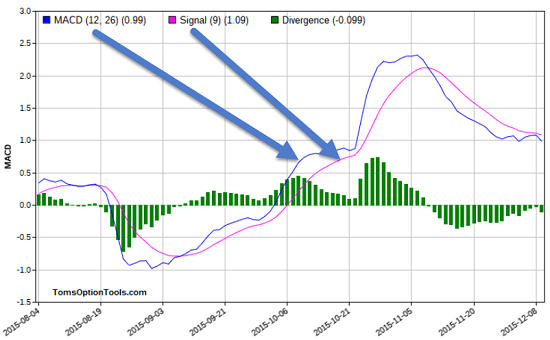
The blue line represents the MACD line and the magenta line is the signal line. The distance between the two lines indicates the strength or weakness of the trend.
Momentum and Strength (or Lack Thereof)
When the stock is in an uptrend, the MACD line should be over the signal line, and when the stock goes up too high too fast, you will see the widest separation between the two. That indicates strength in the uptrend.
In a downtrend, the MACD line should be below the signal line, and the farther and faster the stock declines, the wider the separation between the two. That shows strength in the downtrend.
When the stock is in a sideways trend, the MACD line and the signal line are flat and usually pretty close to each other. That's an indication that the trend of the stock is weak.
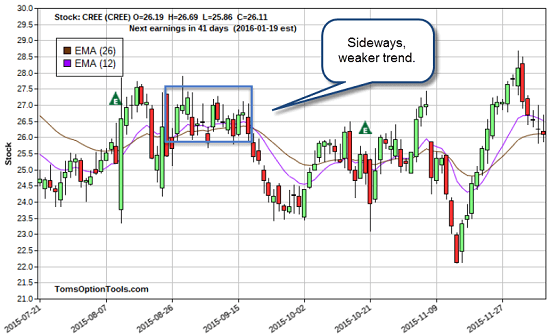
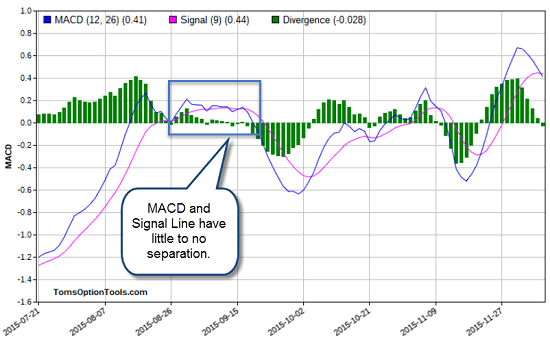
Crossover of the Zero Line
When the 12-period EMA crosses above or below the 26-period EMA, you will see the MACD line cross above or below the zero line in the MACD screen.
Some traders like to initiate a bearish trade when the MACD line crosses below the zero line. Some will be more conservative and wait for both the MACD and signal line to cross below the zero line.
I prefer to try and be in my trades sooner. Let me show you why...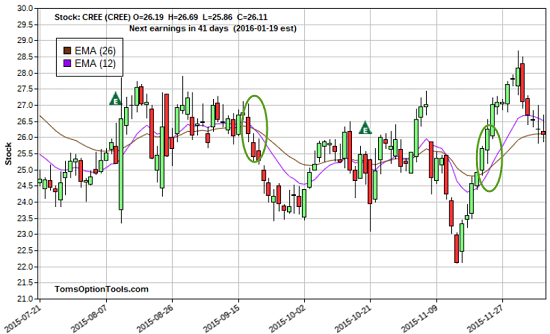
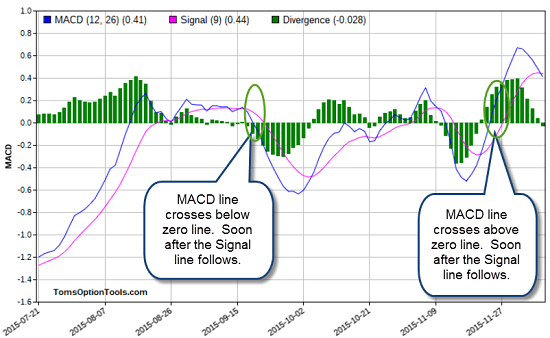
See above: Just after the sideways consolidation in price, the 12-day EMA crossed below the 26-day EMA, and the MACD line crossed below the zero line. It took a day or two more for the signal line to follow suit.
See what I mean by wanting to be in a bit sooner? You can get into (or out of) your trades a day or two early, before the signal line crosses the zero line and the trend or reversal is confirmed.
Towards the end of the chart, you see the 12-day EMA create a bullish cross of the 26-day EMA, which accounts for the MACD line crossing above the zero line, with the signal line following suit a day or two later. Notice the MACD/signal line crossover and when it happened compared to the EMA crossover.
MACD Line Crossover of the Signal Line
Another way a lot of traders (myself included) look to get into trades sooner on a possible reversal is to trade the crossover of the signal line BY the MACD line.
This crossover happens sooner than the EMA crossover, likely due to the fact that moving averages are lagging indicators.
Let me point out here that in neither case am I stating that these crossovers will happen on absolute tops or bottoms. The crossovers may be off by a few days or more, but they do signify a reflection of the strength of current trend and give the indication that a possible reversal of the trend may come about.
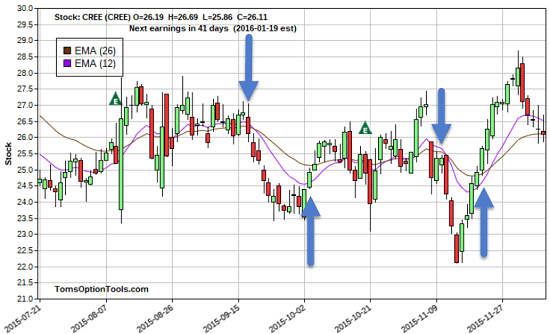
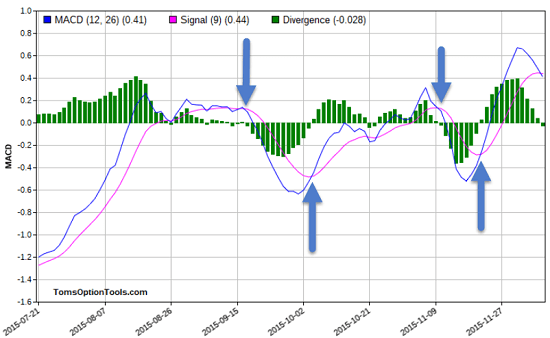
The MACD cross of the signal line may happen a day or two prior to the EMA's crossing. You will also note the MACD cross of the signal line can happen above or below the zero line.
Harnessing "Divergence"
One technical setup with the MACD I find very intriguing (when it works) is positive or negative divergence.
This happens when the crossover in the MACD works counter to the trend of price in the underlying.
When the MACD makes a higher low at the time the price of the underlying makes a lower low, this indicates the undercurrents of momentum could be building and putting in a bottom in price that propels the underlying price higher.
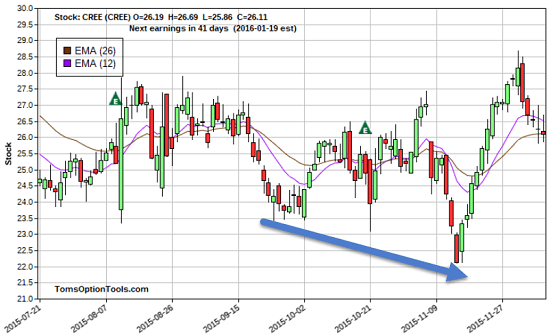
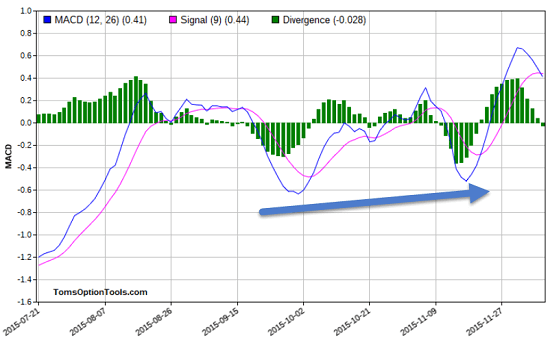
Notice in the images above the lower low in price on the actual stock chart. At the same time in the MACD chart, you will see it making a higher low on its MACD/signal line cross.
This shows a divergence in price - prices were heading lower while momentum was gaining to the upside. Of course, this is only potential upside momentum until it's actually confirmed, which you can see did happen in mid-November.
You can find MACD signals and crossovers by having the technical indicator on your screen and scrolling through thousands of charts, or you can simply choose to look at a select basket of stocks and watch for these MACD/signal line crossovers.
Many brokerages and online trading platforms have these tools available to customers. Check with your broker to see if you can take advantage of these great tools.
Below is a screenshot of my proprietary tool, in which you can see the different MACD scans I have available to me.
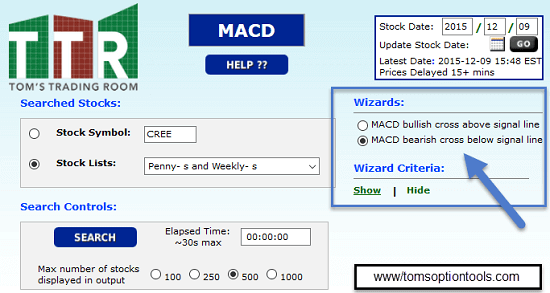
MACD can be used for your entry and/or signal on your trades. The basics I have explained here can be used for (and there are traders out there who do this) entry and exits of your trades. You can use MACD to initiate bullish trades on bullish signals/crosses and plan to exit that position on a bearish signal or cross... and vice versa.
There is a drawback - MACD won't tell you how far a stock can move, nor will it tell you the time frame of your trade.
[mmpazkzone name="in-story" network="9794" site="307044" id="137008" type="4"]
Those are some of the key things we look for as options traders - how much and by when?
So consider MACD and its signals as an accompanying or supporting indicator rather than the sole technical means for your options trades.
Follow us on Twitter @moneymorning or like us on Facebook.
Cash In on Share-Price Breakouts: Stocks often trade between support and resistance lines, a trend called channeling. Channels are helpful because they allow traders to predict a stock's behavior. But all channels eventually break - accurately anticipating when and where is the key to runaway profits...
About the Author
Tom Gentile, options trading specialist for Money Map Press, is widely known as America's No. 1 Pattern Trader thanks to his nearly 30 years of experience spotting lucrative patterns in options trading. Tom has taught over 300,000 traders his option trading secrets in a variety of settings, including seminars and workshops. He's also a bestselling author of eight books and training courses.



